Economy
US, EU reach 15% tariff deal to avert trade war – at least for now
The United States and the European Union reached a trade framework agreement on Sunday to set a 15% tariff on most EU goods, averting, at least for now, a bigger trade war between the two allies that account for almost a third of global trade.
The sweeping announcement came after President Donald Trump and European Commission chief Ursula von der Leyen met briefly at Trump’s Turnberry golf course in Scotland. Their private sit-down culminated months of bargaining, with the White House deadline Friday nearing for imposing punishing tariffs on the EU’s 27 member countries.
“It was a very interesting negotiation. I think it’s going to be great for both parties,” Trump said. The agreement, he said, was “a good deal for everybody” and “a giant deal with lots of countries.”
Von der Leyen said the deal “will bring stability, it will bring predictability, that’s very important for our businesses on both sides of the Atlantic.”
Many facets will require more work
As with other recent tariff agreements that Trump announced with countries including Japan and the United Kingdom, some major details remain pending in this one.
Trump said the EU had agreed to buy some $750 billion worth of U.S. energy and invest $600 billion more than it already is in America – as well as make a major military equipment purchase. He said tariffs “for automobiles and everything else will be a straight across tariff of 15%” and meant that U.S. exporters “have the opening up of all of the European countries.”
Von der Leyen said the 15% tariffs were “across the board, all inclusive” and that “indeed, basically the European market is open.”
At a later news conference away from Turnberry, she said the $750 billion in additional U.S. energy purchases was actually over the next three years – and would help ease the dependence on natural gas from Russia among the bloc’s countries.
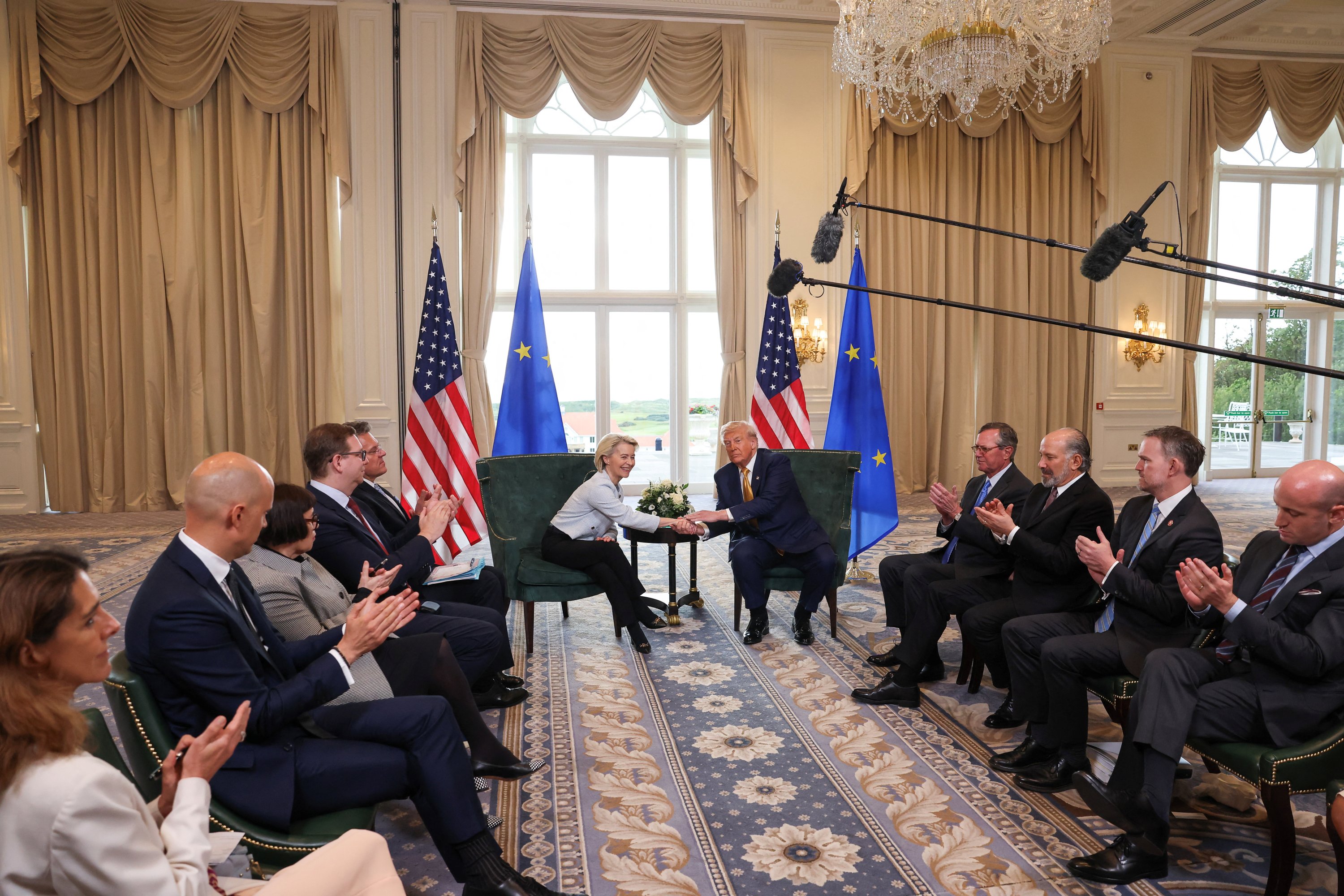
“When the European Union and the United States work together as partners, the benefits are tangible,” Von der Leyen said, noting that the agreement “stabilized on a single, 15% tariff rate for the vast majority of EU exports,” including cars, semiconductors and pharmaceuticals.
“15% is a clear ceiling,” she said.
But von der Leyen also clarified that such a rate wouldn’t apply to everything, saying that both sides agreed on “zero for zero tariffs on a number of strategic products,” like all aircraft and component parts, certain chemicals, certain generic drugs, semiconductor equipment, some agricultural products, natural resources and critical raw materials.
It is unclear if alcohol will be included in that list.
“And we will keep working to add more products to this list,” she said, while also stressing that the “framework means the figures we have just explained to the public, but, of course, details have to be sorted out. And that will happen over the next weeks.”
Further EU approval needed
In the meantime, there will be work to do on other fronts. Von der Leyen had a mandate to negotiate because the European Commission handles trade for member countries. But the Commission must now present the deal to member states and EU lawmakers, who will ultimately decide whether or not to approve it.
Before their meeting began, Trump pledged to change what he characterized as “a very one-sided transaction, very unfair to the United States.”
“I think both sides want to see fairness,” the Republican president told reporters.
Von der Leyen said the U.S. and EU combined have the world’s largest trade volume, encompassing hundreds of millions of people and trillions of dollars and added that Trump was “known as a tough negotiator and dealmaker.”
“But fair,” Trump said.
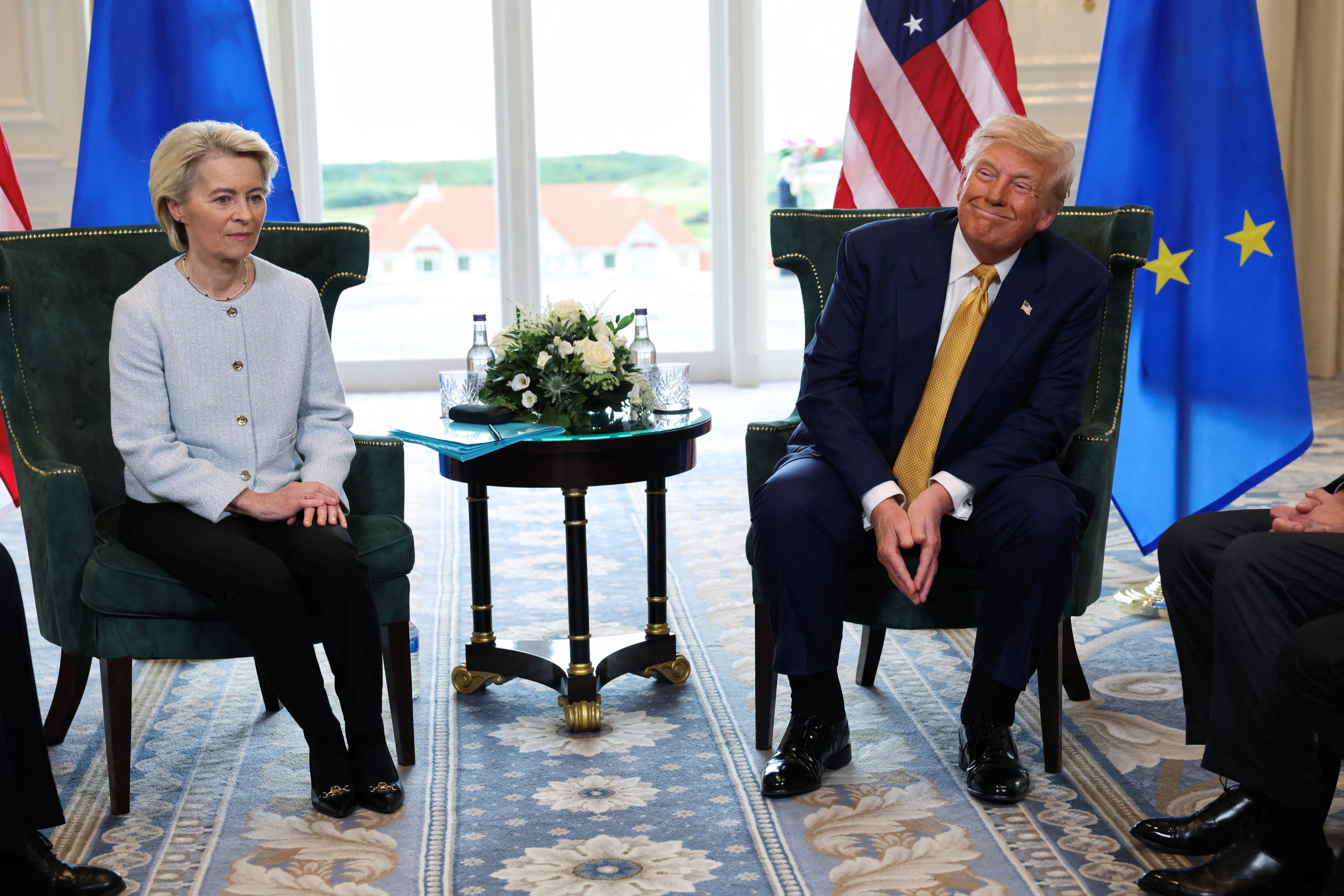
Trump has spent months threatening most of the world with large tariffs in hopes of shrinking major U.S. trade deficits with many key trading partners. More recently, he had hinted that any deal with the EU would have to “buy down” a tariff rate of 30% that had been set to take effect.
But during his comments before the agreement was announced, the president was asked if he’d be willing to accept tariff rates lower than 15%, and he said “no.”
First golf, then trade talk
Their meeting came after Trump played golf for the second straight day at Turnberry, this time with a group that included sons Eric and Donald Jr. In addition to negotiating deals, Trump’s five-day visit to Scotland is built around golf and promoting properties bearing his name.
A small group of demonstrators at the course waved American flags and raised a sign criticizing British Prime Minister Keir Starmer, who plans his own Turnberry meeting with Trump on Monday.
Other voices could be heard cheering and chanting “Trump! Trump!” as he played nearby.
On Tuesday, Trump will be in Aberdeen, in northeastern Scotland, where his family has another golf course and is opening a third next month. The president and his sons plan to help cut the ribbon on the new course.
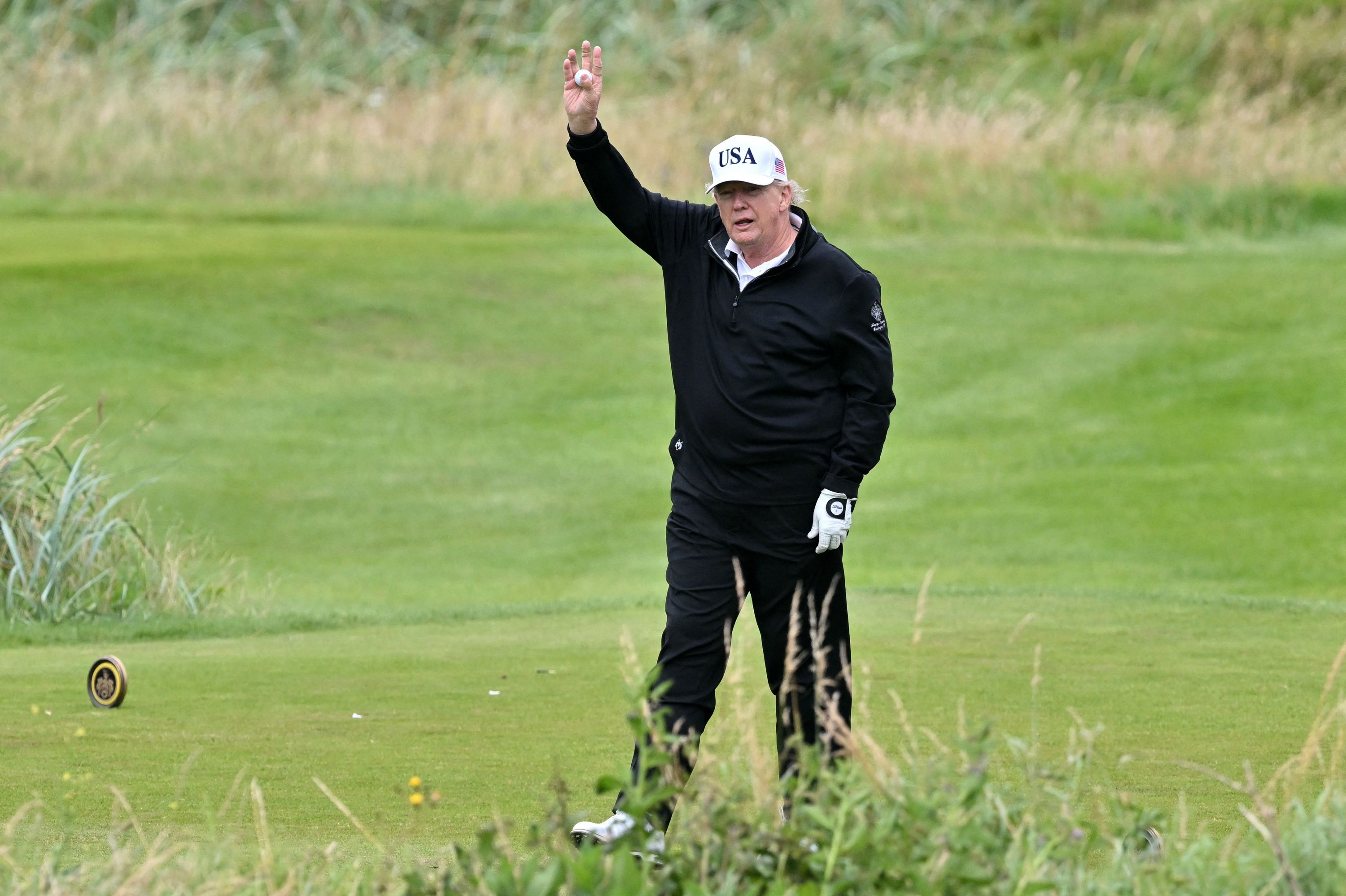
The U.S. and EU seemed close to a deal earlier this month, but Trump instead threatened a 30% tariff rate. The deadline for the Trump administration to begin imposing tariffs has shifted in recent weeks, but is now firm and coming Friday, the administration insists.
“No extensions, no more grace periods. Aug. 1, the tariffs are set, they’ll go into place, Customs will start collecting the money and off we go,” U.S. Commerce Secretary Howard Lutnick told “Fox News Sunday” before the EU deal was announced.
He added, however, that even after that, “people can still talk to President Trump. I mean, he’s always willing to listen.”
Without an agreement, the EU said it was prepared to retaliate with tariffs on hundreds of American products, ranging from beef and auto parts to beer and Boeing airplanes.
If Trump eventually followed through on his threat of tariffs against Europe, meanwhile, it could have made everything from French cheese and Italian leather goods to German electronics and Spanish pharmaceuticals more expensive in the United States.
“I think it’s great that we made a deal today, instead of playing games and maybe not making a deal at all,” Trump said. “I think it’s the biggest deal ever made.”
Economy
French PM Bayrou calls US trade deal ‘dark day for Europe’
French Prime Minister Francois Bayrou called a framework trade deal between the U.S. and European Union a “dark day” for Europe, saying the bloc had caved in to U.S. President Donald Trump’s pressure with an unbalanced deal that slaps a headline 15% tariff on EU goods while sparing U.S. imports from any immediate European retaliation.
The criticism from Bayrou followed months of French calls for EU negotiators to take a tougher stance against Trump by threatening reciprocal measures – a position that contrasted with the more conciliatory approaches of Germany and Italy.
“It is a dark day when an alliance of free peoples, brought together to affirm their common values and to defend their common interests, resigns itself to submission,” Bayrou wrote on X of what he called the “von der Leyen-Trump deal.”
The high-level French criticism and President Emmanuel Macron’s silence since the deal was signed between Trump and European Commission President Ursula von der Leyen stood in stark contrast to the more benign reactions from Berlin and Rome.
French government ministers acknowledged the agreement had some benefits – including exemptions for sectors such as spirits and aerospace – but said it remained fundamentally unbalanced.
“This state of affairs is not satisfactory and cannot be sustained,” French European Affairs Minister Benjamin Haddad said on X, urging the EU to activate its so-called anti-coercion instrument, which would allow for non-tariff retaliation.
Trade Minister Laurent Saint-Martin criticized the EU’s handling of the negotiations, saying the bloc should not have refrained from hitting back in what he described as a power struggle initiated by Trump.
“Donald Trump only understands force,” he told France Inter radio. “It would have been better to respond by showing our capacity to retaliate earlier. And the deal could have probably looked different,” he added.
Macron had said that the EU should respond in kind if Washington slapped tariffs on EU goods and apply equivalent measures on U.S. imports into the bloc, in particular on services, in which the U.S. enjoys a surplus with the EU.
However, the softer line advocated by German Chancellor Friedrich Merz and Italian Prime Minister Giorgia Meloni, whose countries are more dependent on exports to the U.S. than France, prevailed.
Economy
Orban slams US deal, says Trump ‘ate’ EU chief ‘for breakfast’
Hungarian Prime Minister Viktor Orban on Monday lashed out at a new trade deal the European Union reached a day earlier with the U.S., saying the agreement is “worse” than the deal the U.K. clinched.
“Donald Trump did not reach an agreement with Ursula von der Leyen, but rather Donald Trump ate Ursula von der Leyen for breakfast,” Orban said during a Facebook livestream hosted by his party’s spokesperson.
The framework trade agreement, which the U.S. and the EU agreed upon on Sunday, is worse than the trade deal that the U.K. reached with the U.S. earlier, he was also quoted as saying.
The deal imposes a 15% import tariff on most EU goods – half the threatened rate.
“This is not an agreement … (President) Donald Trump ate (European Commission President) Von der Leyen for breakfast, this is what happened and we suspected this would happen as the U.S. President is a heavyweight when it comes to negotiations, while Madame President is a featherweight,” Orban said.
Economy
US, Chinese officials meet again in effort to extend tariff truce
Top U.S. and Chinese economic officials are set to meet again on Monday to renew trade negotiations with an extension of lower tariff levels on the cards.
Talks between the world’s two largest economies are scheduled to take place over two days in Stockholm, the Swedish capital and come as other countries rush to finalize deals with Washington.
For dozens of trading partners, failing to strike an agreement in the coming days means they could face significant tariff hikes on exports to the U.S. come Friday, Aug. 1.
The steeper rates, threatened against partners like Brazil and India, would raise the duties their products face from a “baseline” of 10% now to levels up to 50%.
Tariffs imposed by the Trump administration have already effectively raised duties on U.S. imports to levels not seen since the 1930s, according to data from The Budget Lab research centre at Yale University.
For now, all eyes are on discussions between Washington and Beijing as a delegation including U.S. Treasury Secretary Scott Bessent meets a Chinese team led by Vice Premier He Lifeng in Sweden.
Beijing said on Monday it hoped the two sides could hold talks in the spirit of “mutual respect and reciprocity.”
Foreign Ministry spokesperson Guo Jiakun said Beijing sought to “enhance consensus through dialogue and communication, reduce misunderstandings, strengthen cooperation and promote the stable, healthy and sustainable development of China-U.S. relations.”
While both countries imposed tariffs on each other’s products in April, reaching triple-digit levels, U.S. duties this year have been temporarily lowered to 30%, and China’s countermeasures have been slashed to 10%.
But the 90-day truce, instituted after talks in Geneva in May, is set to expire on Aug. 12.
Since the Geneva meeting, the two sides have convened in London to iron out disagreements.
China progress?
“There seems to have been a fairly significant shift in (U.S.) administration thinking on China since, particularly the London talks,” said Emily Benson, head of strategy at Minerva Technology Futures.
“The mood now is much more focused on what’s possible to achieve, on warming relations where possible and restraining any factors that could increase tensions,” she told Agence France Presse (AFP).
Talks with China have not produced a deal, but Benson said both countries have made progress, with certain rare earth and semiconductor flows restarting.
“Secretary Bessent has also signalled that he thinks a concrete outcome will be to delay the 90-day tariff pause,” she said. “That’s also promising, because it indicates that something potentially more substantive is on the horizon.”
The South China Morning Post, citing sources on both sides, reported Sunday that Washington and Beijing are expected to extend their tariff pause by another 90 days.
Trump has announced pacts so far with the European Union, Britain, Vietnam, Japan, Indonesia and the Philippines, although details have been sparse.
An extension of the U.S.-China deal to keep tariffs at reduced levels “would show that both sides see value in continuing talks,” said Thibault Denamiel, a fellow at the Centre for Strategic and International Studies.
U.S.-China Business Council President Sean Stein said the market was not anticipating a detailed readout from Stockholm: “What’s more important is the atmosphere coming out.”
“The business community is optimistic that the two presidents will meet later this year, hopefully in Beijing,” he told AFP.
“It’s clear that on both sides, the final decision-maker is going to be the president.”
Far from ideal
For others, the prospect of higher U.S. tariffs and few details from fresh trade deals marks “a far cry from the ideal scenario,” said Denamiel.
But they show some progress, particularly with partners that Washington has signaled are on its priority list, like the EU, Japan, the Philippines and South Korea.
The EU unveiled a pact with Washington on Sunday, while Seoul is rushing to strike an agreement, following Japan and the Philippines, which have already reached the outlines of deals.
Breakthroughs have been patchy since Washington promised a flurry of agreements after unveiling and then swiftly postponing tariff hikes targeting dozens of economies in April.
Denamiel warned of overlooking countries that fall outside Washington’s priority list.
Solid partnerships are needed, he said, if Washington wants to diversify supply chains, enforce advanced technology controls, and tackle excess Chinese capacity.
Economy
Google admits failure to alert millions during Türkiye’s 2023 quakes
Google has acknowledged that its early warning system had failed to deliver critical alerts to millions of people during Türkiye’s deadliest earthquakes more than two years ago, a report said on Monday.
Had the algorithms functioned properly, around 10 million people within 157 kilometers (97.56 miles) of the epicenter could have received the highest-level warning up to 35 seconds before the shaking began.
In reality, just 469 people received the alert during the first 7.8 magnitude quake that struck southeastern Türkiye in the early hours of Feb. 6, 2023, while roughly 500,000 received a lower-level notification for mild tremors, Google told the BBC.
The tech giant previously said the system, named Android Earthquake Alerts (AEA), had “performed well.”
More than 55,000 people died and over 100,000 were injured in the twin tremors, many of them caught in their sleep.
The AEA is run by the Silicon Valley firm, not individual countries. It works on Android devices, which are said to make up more than 70% of the phones in Türkiye.
The highest-level alert in AEA is the “Take Action” warning. It triggers a loud alarm that bypasses the Do Not Disturb mode and takes over the phone’s screen. This alert is intended for situations where intense shaking is detected and poses a danger to human life.
A lower-level alert, called “Be Aware,” notifies users about possible mild tremors. Unlike the more urgent warning, it doesn’t interrupt devices that are set to Do Not Disturb.
Google’s early warning system was in place and live on the day of the Feb. 6 quakes. However, it underestimated how strong the tremors were.
It initially estimated the magnitude of the first earthquake at 4.5-4.9 rather than the actual 7.8, BBC cited researchers as explaining in the Science journal.
A similar underestimation occurred during the second quake, leading to only 8,158 phones receiving the “Take Action” alert and 4 million getting the less urgent “Be Aware” notification.
Following the disaster, Google revised its algorithms and ran simulations showing that the updated system would have delivered “Take Action” alerts to 10 million devices and “Be Aware” notifications to 67 million people.
“Every earthquake early warning system grapples with the same challenge – tuning algorithms for large magnitude events,” Google told the BBC. The company argued that its alerts are not a replacement for national warning systems.
Critics, however, say the two-year delay in disclosing the system’s failure is unacceptable.
“We’re not talking about a little event – people died – and we didn’t see a performance of this warning in the way we would like,” Elizabeth Reddy, assistant professor at Colorado School of Mines, told the BBC.
Economy
Google admits failure to alert millions during Türkiye’s 2023 quakes
Google has acknowledged that its early warning system had failed to deliver critical alerts to millions of people during Türkiye’s deadliest earthquakes more than two years ago, a report said on Monday.
Had the algorithms functioned properly, around 10 million people within 157 kilometers (97.56 miles) of the epicenter could have received the highest-level warning up to 35 seconds before the shaking began.
In reality, just 469 people received the alert during the first 7.8 magnitude quake that struck southeastern Türkiye in the early hours of Feb. 6, 2023, while roughly 500,000 received a lower-level notification for mild tremors, Google told the BBC.
The tech giant previously said the system, named Android Earthquake Alerts (AEA), had “performed well.”
More than 55,000 people died and over 100,000 were injured in the twin tremors, many of them caught in their sleep.
The AEA is run by the Silicon Valley firm, not individual countries. It works on Android devices, which are said to make up more than 70% of the phones in Türkiye.
The highest-level alert in AEA is the “Take Action” warning. It triggers a loud alarm that bypasses the Do Not Disturb mode and takes over the phone’s screen. This alert is intended for situations where intense shaking is detected and poses a danger to human life.
A lower-level alert, called “Be Aware,” notifies users about possible mild tremors. Unlike the more urgent warning, it doesn’t interrupt devices that are set to Do Not Disturb.
Google’s early warning system was in place and live on the day of the Feb. 6 quakes. However, it underestimated how strong the tremors were.
It initially estimated the magnitude of the first earthquake at 4.5-4.9 rather than the actual 7.8, BBC cited researchers as explaining in the Science journal.
A similar underestimation occurred during the second quake, leading to only 8,158 phones receiving the “Take Action” alert and 4 million getting the less urgent “Be Aware” notification.
Following the disaster, Google revised its algorithms and ran simulations showing that the updated system would have delivered “Take Action” alerts to 10 million devices and “Be Aware” notifications to 67 million people.
“Every earthquake early warning system grapples with the same challenge – tuning algorithms for large magnitude events,” Google told the BBC. The company argued that its alerts are not a replacement for national warning systems.
Critics, however, say the two-year delay in disclosing the system’s failure is unacceptable.
“We’re not talking about a little event – people died – and we didn’t see a performance of this warning in the way we would like,” Elizabeth Reddy, assistant professor at Colorado School of Mines, told the BBC.
Economy
Turkish economy reenters ‘positive cycle,’ receives rating upgrade
The Turkish economy has reentered a “positive cycle,” overcoming the period of domestic and international uncertainties and difficulties, a top official said on Saturday, reiterating the aim to lower inflation.
“Our country’s credit rating has been upgraded. Our economy has overcome a period of domestic and international uncertainties and challenges, reentering a positive cycle,” Treasury and Finance Minister Mehmet Şimşek said in a post on X, referring to the latest upgrade of Türkiye’s rating by Moody’s.
Moody’s raised Türkiye’s long-term debt rating one notch, from “B1” to “Ba3,” with a “stable” outlook, the credit rating agency said on Friday.
Moody’s justified its decision by citing effective economic policies that have helped restore investor confidence in the Turkish lira.
It also highlighted the central bank’s commitment to the tight monetary policy that “durably eases inflationary pressures” and “reduces economic imbalances.”
“This rating increase confirms our successful management of the process and the resilience of our economy,” Şimşek further said.
“We are determined to permanently reduce inflation, maintain the current account deficit at a sustainable level, and strengthen budget discipline, excluding earthquake-related expenditures,” he added.
In a televised interview on Sunday, Şimşek reiterated his statement about returning to the “positive cycle,” citing the recovery in reserves since March.
“Our reserves were over $170 billion in mid-March and have now returned to that level. Therefore, we are back to the levels we were before these shocks began,” he noted.
“Our CDSs were around 256, reached 300, and now they are around 280 again,” he added. At the same time, he also pointed out that financial conditions have now eased, noting that growth continues at a moderate pace and that they have not experienced a significant deterioration in the current account deficit.
Regarding inflation goals, he recalled that the year-end inflation forecast is between 24% and 29%.
“We anticipate a midpoint between those figures. The core of our program is to combat the cost of living. That is, to permanently reduce inflation and increase our citizens’ purchasing power,” he said.
The annual inflation rate in Türkiye eased to 35.05% in June, slowing down significantly from around 75% in May 2024, according to official data.
The minister also said on X on Saturday that they aim to make “the gains of our program permanent through reforms that will drive structural transformation in industry, particularly in green and digital transformation.”
“As we continue to implement our program with patience and determination, our risk premium will further decrease, access to financing will increase and new rating upgrades will follow,” Şimşek said.
The Turkish government has been implementing an economic program with the main aim of lowering inflation to single digits, while also focusing on issues such as green and digital transformation, tax evasion and reducing the budget and current account deficits.
The Turkish central bank cut its key interest rate from 46% to 43% on Thursday, a slightly larger-than-expected reduction.
The institution began a series of rate cuts in December as inflation slowed, but on Thursday, it predicted a temporary rebound in monthly inflation in July.
In the longer-term, it expects inflation to ease to 24% by the end of this year and 12% by the end of 2026.
Apart from Moody’s, Fitch Ratings also affirmed the country’s rating at “BB-” on Friday, maintaining a “stable” outlook.
-

 Politics3 days ago
Politics3 days agoAnkara condemns Israeli parliament’s call to annex occupied West Bank
-

 Economy3 days ago
Economy3 days agoTürkiye says defense exports to ‘easily’ exceed $8 billion in 2025
-

 Daily Agenda3 days ago
Daily Agenda3 days agoMartyr Akut staff was sent off on their last journey
-

 Daily Agenda3 days ago
Daily Agenda3 days agoMinister of Terrorism from Minister Tunç: “The process will be successful”
-
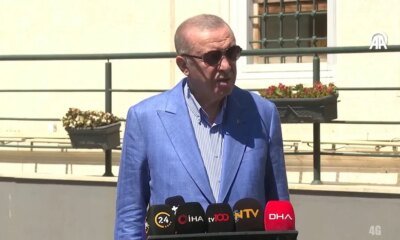
 Daily Agenda3 days ago
Daily Agenda3 days agoLast minute | IMPORTANT EXPLANATIONS FROM PRESIDENT ERDOĞAN: I can meet with Putin and Trump
-

 Daily Agenda2 days ago
Daily Agenda2 days agoCrises do not end in Buca Municipality: First salary is now promotion!
-
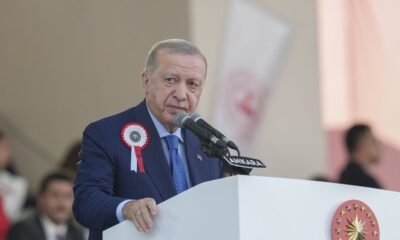
 Politics3 days ago
Politics3 days agoNo sabotage, trap will hinder terror-free Türkiye initiative: Erdoğan
-
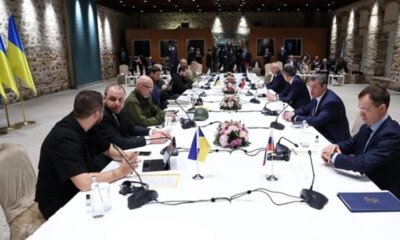
 Daily Agenda3 days ago
Daily Agenda3 days agoNew Stage in the ‘Peace Desk’: Three working groups will be established




